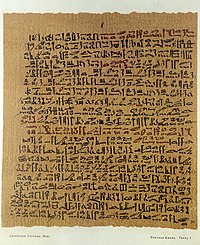Our website is made possible by displaying online advertisements to our visitors.
Please consider supporting us by disabling your ad blocker.
Egyptian language
| Egyptian | |||||||
|---|---|---|---|---|---|---|---|
| |||||||
 | |||||||
| Region | Originally, throughout Ancient Egypt and parts of Nubia (especially during the times of the Nubian kingdoms)[2] | ||||||
| Ethnicity | Ancient Egyptians | ||||||
| Era | Late fourth millennium BC – 19th century AD[note 2] (with the extinction of Coptic); still used as the liturgical language of the Coptic Orthodox and Coptic Catholic Churches | ||||||
Afro-Asiatic
| |||||||
| Dialects |
| ||||||
| Hieroglyphs, cursive hieroglyphs, Hieratic, Demotic and Coptic (later, occasionally, Arabic script in government translations and Latin script in scholars' transliterations and several hieroglyphic dictionaries[5]) | |||||||
| Language codes | |||||||
| ISO 639-2 | egy (also cop for Coptic) | ||||||
| ISO 639-3 | egy (also cop for Coptic) | ||||||
| Glottolog | egyp1246 | ||||||
| Linguasphere | 11-AAA-a | ||||||
Egyptian was an Afroasiatic language that was spoken in Ancient Egypt. It has been written 5000 years, which makes it one of the oldest written languages known today. The Coptic language is the modern form of the Egyptian language. The Egyptian language changed into it over time. The Copts use it for religious purposes. Only a few people are still fluent in Coptic.[6] While the modern variant is known, the older variants could only be translated when the Rosetta stone was found in 1799. The Rosetta stone contains the same text in three languages, one of which was known at the time.
The oldest records of the Egyptian language date from about 3400 BC.[7]
Egyptian was spoken until the late 17th century AD in the form of Coptic. The national language of modern-day Egypt is Egyptian Arabic, which replaced Coptic as the language of daily life in the centuries after the Muslim conquest of Egypt.[8]
- ↑ Erman & Grapow 1926–1961.
- ↑ "Ancient Sudan~ Nubia: Writing: The Basic Languages of Christian Nubia: Greek, Coptic, Old Nubian, and Arabic". ancientsudan.org. Archived from the original on 5 January 2009. Retrieved 2017-03-09.
{{cite web}}: CS1 maint: unfit URL (link) - ↑ 3.0 3.1 Allen 2000, p. 2.
- ↑ 4.0 4.1 Loprieno 1995, p. 8.
- ↑ Budge, E. A. Wallis (1920). Egyptian Hieroglyphic Dictionary (PDF). London: Harrison and sons. Archived (PDF) from the original on 2017-12-12.
- ↑ "Coptic language’s last survivors". Daily Star Egypt, December 10, 2005 (archived)
- ↑ "Inscriptions Suggest Egyptians Could Have Been First to Write". The New York Times. 16 December 1998. Retrieved 1 May 2010.
- ↑ The language may have survived in isolated pockets in Upper Egypt into the 19th century according to James Edward Quibell, "When did Coptic become extinct?" in Zeitschrift für ägyptische Sprache und Altertumskunde, 39 (1901), p. 87.
<ref group=note> tags on this page, but the references will not show without a {{reflist|group=note}} template (see the help page).
Previous Page Next Page


